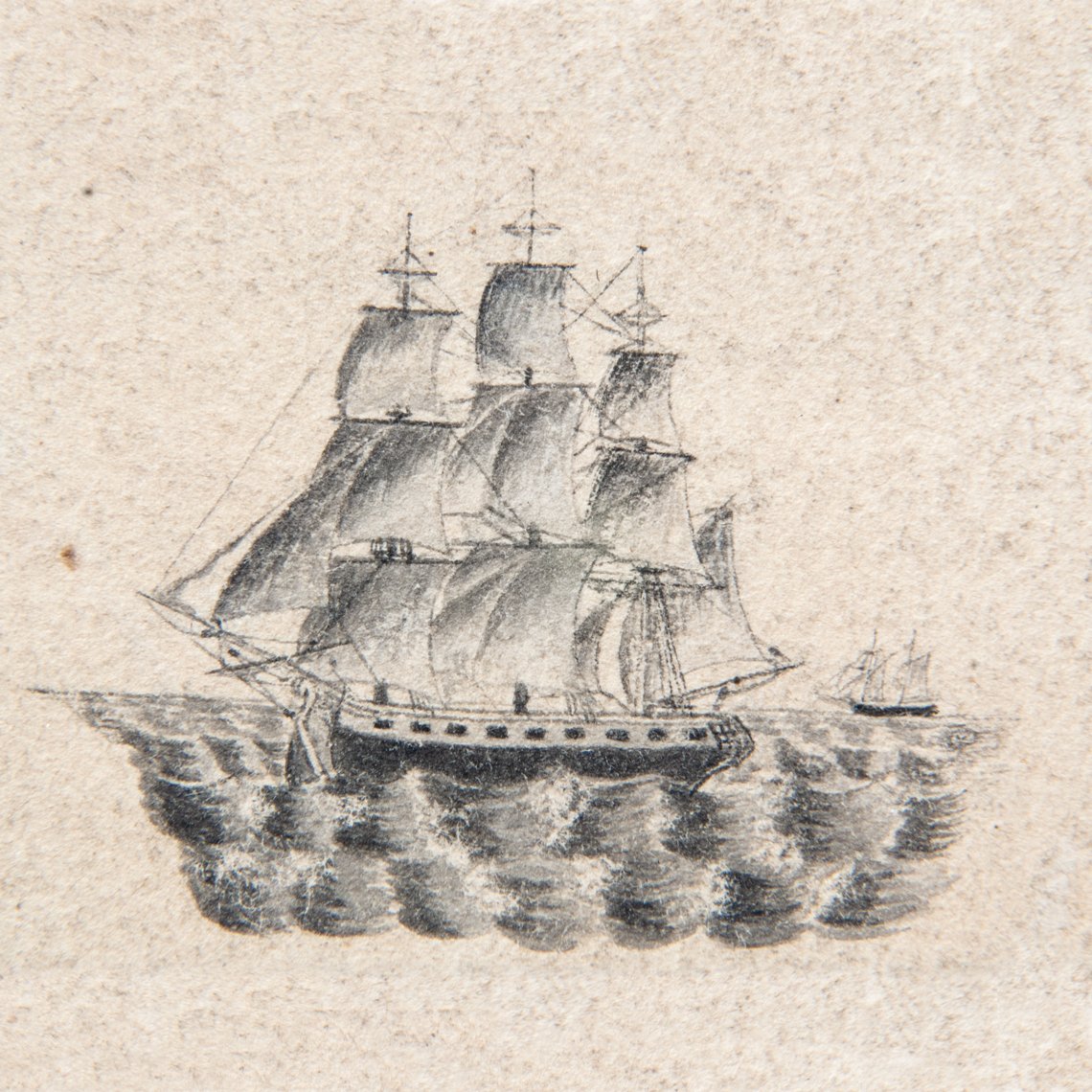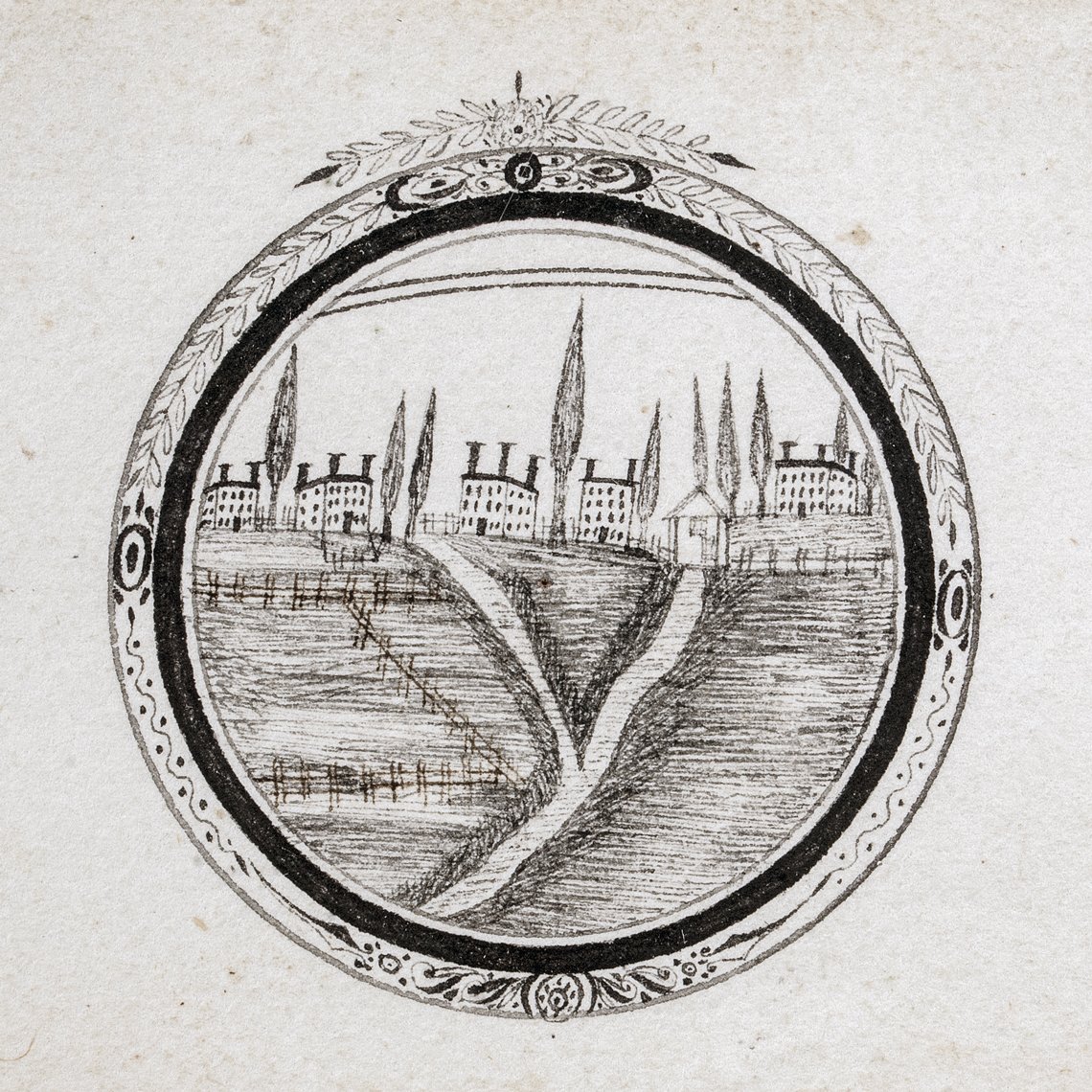It’s a Small World: The Micro-Drawings of Rufus E. Patten
Rufus E. Patten (1807–1879) is not well-known today. He was, however, something of a beloved figure in his own time in his native town of Candia, New Hampshire, a small community in Rockingham County, not far from Manchester, settled in 1748. About Patten, Wilson Palmer, a town historian writing in 1910, asked, “Who in Candia doesn’t remember him?” 1 Palmer goes on to extoll Patten’s virtues for several hundred words. Among those attributes, not noted at the time, was his considerable virtuosity as a draftsman, as evidenced by his micro drawings included in New Hampshire Folk Art: By the People, For the People, on view at the Portsmouth Historical Society, through September 29, 2019. The exhibition features works of art created outside the formal academic tradition by artists, craftsmen, and other individuals from the Granite State.
 |
clockwise from right Fig. 1: Silhouette of Rufus E. Patten, unknown artist, N.H., ca. 1830. Pen and ink on paper; Framed 6⅞ x 6 inches. Collection of Craig and Alison Jewett. The silhouette has a pencil note on the back: “belonged to Agnes Miller Ronald of Exeter, N.H. It was framed in about 1940 by Goodspeed in Boston. The name on the silhouette seems to be Rufus E. Patten.” Agnes Johnston Miller Ronald (1866–1926) was the wife of John Reid Ronald (1864–1941). Given the information concerning when the silhouette was framed, it likely was taken to Goodspeed’s by Mr. Ronald. Fig. 2: Rufus E. Patten (1807–1879), penmanship example, ca. 1825–1835. Ink on paper, 1¾ x 2⅞ inches. Signed “R.E. Patten.” Collection of Craig and Alison Jewett. Fig. 3: Rufus E. Patten (1807–1879), penmanship example, ca. 1825–1835. Ink on paper, 1¾ x 2⅞ inches. Signed “R.E. Patten.” Collection of Craig and Alison Jewett. |
 | |
Fig. 4: Rufus E. Patten (1807–1879), Man in top hat, ca. 1825–1835. Ink on paper, 2⅝ x 3½ inches. Collection of Craig and Alison Jewett. |
So, who was Rufus E. Patten? His great-grandparents came to the New World from Cheshire, England, in the early eighteenth century. Rufus’s grandfather, Thomas, was born in Boston in 1725, and was living in Candia by 1752, when he married Mary McClure there. Thomas and Mary had twelve children, including Rufus’s father, the grandly named Samuel George Washington Patten, born in 1779. Samuel married Lydia Emerson (1783–1851) in Candia on September 10, 1807. Their first child was Rufus Emerson Patten, born on October 22, 1807. Some quick calculations suggest that Lydia was about seven months pregnant at the time of her marriage.
Rufus grew up in Candia and was married there in 1834 to Mary B. Hall (1813–1854). The couple would have one child, Mary Elizabeth Patten (1838–1898). Through serendipity and the connective power of the internet, a silhouette (Fig. 1) was recently “discovered,” with a faint period inscription on the front indicating the subject is Rufus E. Patten. It shows an elegantly coiffed young man and appears to have been created at about the time Patten was executing the drawings discussed here.2
A cache of about a dozen of Patten’s tiny drawings have survived; saved perhaps by a family member.3 Done with a very fine point and probably with the aid of a magnifying device, they include examples of his penmanship (Figs. 2, 3), giving his name in all caps and with some decorative flourishes. Another drawing features a walking or marching man decked out in striped trousers, a short waistcoat, and a large top hat (Fig. 4).
 |  | |
| left Fig. 5: Rufus E. Patten (1807–1879), Ship at sea, ca. 1825–1835. Ink on paper, 1¼ x 1⅝ inches. Collection of Craig and Alison Jewett. right Fig. 6: Rufus E. Patten (1807–1879), Two ships at sea, ca. 1825–1835. Ink on paper, 1¼ x 2 inches. Collection of Craig and Alison Jewett. | ||
A group of nautical images forms a subcategory of Patten’s surviving work. These include a single ship at sea (Fig. 5) amidst wind-swept waves and one with a large ship in the foreground and a small one just visible in the distance (Fig. 6). A battle scene depicting two ships firing at each other (Fig. 7) is labeled “Hornet,” followed by an ampersand (or perhaps simply a flourish). This view would appear to be taken from a print of the USS Hornet taking the HMS Penguin on March 23, 1815, a battle that took place after the War of 1812 was officially over. The encounter was memorialized in a view published about 1815 that was also available in later versions.4
The most detailed battle scene (Fig. 8) shows an American town (as indicated by the flag) under bombardment from two ships, presumably English, at sea. Four cannonballs are about to crash into the town, which contains a number of houses and two churches with tall steeples. On the shore, massed troops supported by cannon fire are ready to repulse what appears to be a landing party in three small boats—the one closest to the shore might even be sinking. One could guess that this image is based on the English siege of Fort McHenry in Baltimore in September 1814, which is perhaps why Patten chose to show Old Glory so prominently, but it could represent any number of battle scenes.
|
| Fig. 7: Rufus E. Patten (1807–1879), Battle at sea, ca. 1825–1835. Ink on paper, 2¼ x 3¼ inches. Inscribed “Hornet &.” Collection of Craig and Alison Jewett. |
 |
Fig. 8: Rufus E. Patten (1807–1879), Bombardment scene, ca. 1825–1835. Ink on paper, 3 x 4⅛ inches. Collection of Craig and Alison Jewett. |
 |
Fig. 9: Rufus E. Patten (1807–1879), Harbor scene, ca. 1825–1835. Ink on paper, ¾ x 1⅜ inches. Collection of Craig and Alison Jewett. |
 | |
Fig. 10: Rufus E. Patten (1807–1879), Landscape with buildings, ca. 1825–1835. Ink on paper, 2⅛ x 2¾ inches. Diam. 1½ inches. Collection of Craig and Alison Jewett. |
Ships in a harbor—Portsmouth, New Hampshire, perhaps?—feature in a peaceful townscape (Fig. 9) that depicts outlines of a dozen or more buildings on a small knoll rising above a waterfront that contains two vessels.
Two of Patten’s most complex drawings are enclosed in circular borders. One directs the viewer’s eye to follow a Y-shaped path through fenced fields (Fig. 10). The right-hand path leads to a small pent-roof structure. Across the width of the landscape are a group of three- and four-story buildings, separated by tall evergreen trees.
A related work (Fig. 11) shows a small domestic-scale dwelling, with several trees and a fenced-in field in the front. To the right, in the distance beyond a post-and-rail fence, is a large three-story building with an institutional appearance. Featuring a projecting center section with a triangular pediment, it resembles Dartmouth Hall, built in 1784, a landmark of the Dartmouth College campus; the scene could also represent another New England collegiate building.5 The circular border here is embellished at the top with a charming drawing of a dove.
The biographical sketch by Wilson Palmer describes some aspects of Patten’s personality and character that may have enabled him to execute such tiny, painstaking works. Palmer, according to Patten, “never hastened matters . . . He recognized the fact that ‘the world was not made in a day,’ so he was willing to take his time.” That Patten did not pursue the often-solitary career as an artist, may have been in part because he was a “. . . fluent conversationalist . . . the listener, however much in haste he might have been, taking little note of time.” 6
 | |
Fig. 11: Rufus E. Patten (1807–1879), Landscape with three-story building. Border embellished with dove, ca. 1825–1835. Ink on paper, 3¾ x 4½ inches. Diam. 1⅞ inches. Collection of Craig and Alison Jewett. |
Interested in politics, Patten was “a democrat of the Jeffersonian stamp.” In addition to being a farmer, he “filled nearly every public position in his town,” including that of town moderator from 1842 to 1850, and again in 1853, as well as justice of the peace. He is said to have presided fairly and gracefully at town meeting and was credited with introducing the custom of beginning each meeting with a prayer.7 He was a member of the Masonic Lodge and also served in the local regiment, as a field officer and later lieutenant colonel. In 1850, he was elected to the New Hampshire House of Representatives. A few years before his death, he accepted the task of placing small marble monuments over the graves of 118 soldiers who were buried in Candia. Two of his diaries survive, and one from 1869–1870 indicates the growing importance of religion in his life as he grew older. His well-attended funeral in 1879, held at the Methodist Church, was marked by Masonic honors.8
Although he didn’t pursue an artistic career, Patten’s tiny drawings remind us that folk art can be found in many places and in many sizes. Despite all his public service and personal qualities, he is likely to be best remembered for these miniature triumphs of draftsmanship that have miraculously survived the vicissitudes of time.
 |
New Hampshire Folk Art: By the People, For the People, was organized by the Portsmouth Historical Society and is on view at Discover Portsmouth Center in Portsmouth, New Hampshire, through September 29, 2019. For more details, call 603.436.8433 or visit portsmouthhistory.org.
1. Wilson Palmer, Reminiscences of Candia (Cambridge, Mass.: Riverside Press, 1910), 289–292.
2. I am grateful to Sally Starr of Starr Antiques, Denver, Colo., for her assistance with the silhouette, and to Craig and Alison Jewett for acquiring it expeditiously.
3. The works illustrated are in the collection of Craig and Alison Jewett, who acquired them in 2014 from Joan R. Brownstein of Newbury, Mass. Prior to that, they were in the collection of Philip M. and Deborah N. Isaacson of Lewiston, Me, and were exhibited at the Bates College Museum of Art in 2008.
4. Abel Bowen, The Naval Monument (Boston: George Clark, 1816[?]), 36.
5. The original Dartmouth Hall burned in 1904 but was re-built following the original plans. It remains a landmark of the Dartmouth campus.
6. Palmer, Reminiscences, 290.
7. Palmer, Reminiscences, 291.
8. See also J. Bailey Moore, History of the Town of Candia, Rockingham County, N.H. (Manchester, N.H.: George W. Browne, 1893. Two Patten diaries, one from 1862 and one from 1869–70, are in the Rauner Special Collections Library at Dartmouth College, along with a number of official military documents. See Manuscript MS-930, with a finding aid on-line.
Gerald W.R. Ward is the consulting curator and editor of the Portsmouth Marine Society Press at the Portsmouth Historical Society; the Katharine Lane Weems Senior Curator of American Decorative Arts and Sculpture Emeritus, Museum of Fine Arts, Boston; and an adjunct faculty member at the Massachusetts College of Art and Design. He is also a New Hampshire State Representative.
The author is grateful to Craig and Alison Jewett for graciously bringing the Patten material to his attention; to Ralph Morang for his photographs; and to Meredith Affleck and Barbara McLean Ward for their assistance.
Photography, with the exception of figure 1, by Ralph Morang.
This article was originally published in the Autumn 2019 issue of Antiques & Fine Art magazine, a fully digitized version of which is available at www.afamag.com. AFA is affiliated with Incollect.com.




























